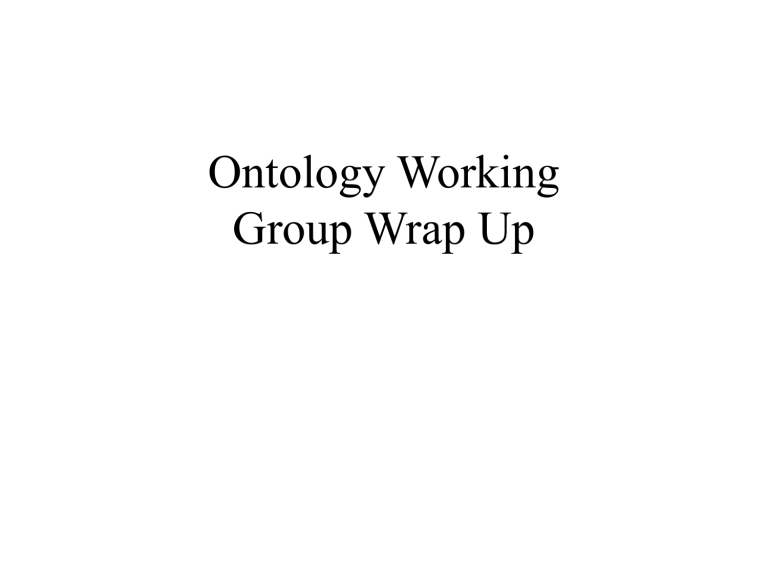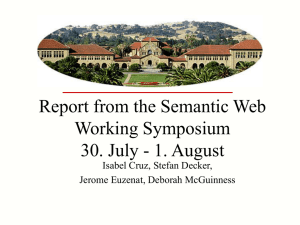Ontology Working Group Wrap Up

Ontology Working
Group Wrap Up
What are Ontologies?
• Conceptualizations of real world
• Often derived in Consensus processes or enforced by entities
• Variety of content and representations
– Thesauri, Dictionary, Taxonomies, DB Schema
– XML Schema, DTDs, UML, RDF Schema
– Might contain is_a, classes, partof, operations,
Behaviour axioms, synonyms, hyponym
Representational Constructs
• Classes, attributes
• Relationships
– Is-a, part-of, non-standard
• Events with Spatio-temporal characteristics
• Uncertainties ?
• Visual/Iconic constructs
• Multiple Languages
Examples of Applications
• Standards
– UMLS Metathesaurus
– Yahoo, Open Directory
– Business Process Modeling Initiative (BPMI)
– XML-HR Initiative (Human Resouces)
– PapiNet (Paper Industry)
• Application
– Genom Research Exchange
– B2B Exchange (product catalog interoperation, business process interoperation)
– Mediation across multi-lingual ontologies
Next Step
• Challenges for the Database Community
– Storing, retrieval, querying
– Browsing, interoperation
• Of heterogeneous Ontologies
Database Issues
• Support for Ontologies
• Acquiring Ontologies
• Machine Learning
• Learning from User Practices
• Reusing existing Ontologies
• Ontology Merging
(resolution of differences/mismatch in representing same or similar things)
Database Issues for Ontology
Management
• Support technology depends on the tasks to perform
• Comprehensive Data Management support requires the identification of the ontology life cycle
Requirements/
Analysis
Ontology
Learning
Consistency
Checking
Ontology Search
Compare/Similarity
Merge/
Refine/Assemble
Evaluation
Maintenance
Versioning
Creation/
Change
Deployment
(e.g., Hypothesis Generation, Query)
DB Research in the Ontology
LifeCycle
• Operations to compare Models/Ontologies
• Scalability/Storage Indexing of Ontologies
– DB approaches data model specific
– Need to support graph based data models
• Temporal Query Languages
DB Research in the Ontology
LifeCycle II
• Schema Mapping
– Meta Model specific
– Representation of exceptions, e.g., tweety
– Specification of Inexact Schema Correspondences
• E.g., 40% of animals are 30% of humans
• Meta Model Transformations/Mappings (e.g.,
UML to RDF Schema)
DB Research in the Ontology
LifeCycle III
• Ontology Versioning
– Collaborative editing
– Meta Model specific versioning
– Version of Schema/Meta Model
Transformations
DB Research & Semantic
Interoperation
• Inference v/s Query Rewriting/Processing for Semantic Integration:
• E.g., RichPerson = (AND Person (> Salary 100))
• Can Query Processing/Concept Rewriting provide the same functionality as inferences ? More efficiently ?
• Distributed Inferences and Loss of Information
• Query Languages for combining metadata and data queries
• Graph-based data models and query languages
• Schema Correspondences/Mappings (Repeat from previous slide)
•Intensional Answers (Answers are descriptions, e.g. (AND Person (>
Salary 100)) instead of a list of all rich people)
•Semantic Associations (identification of meaningful relationships between different types of instances)





